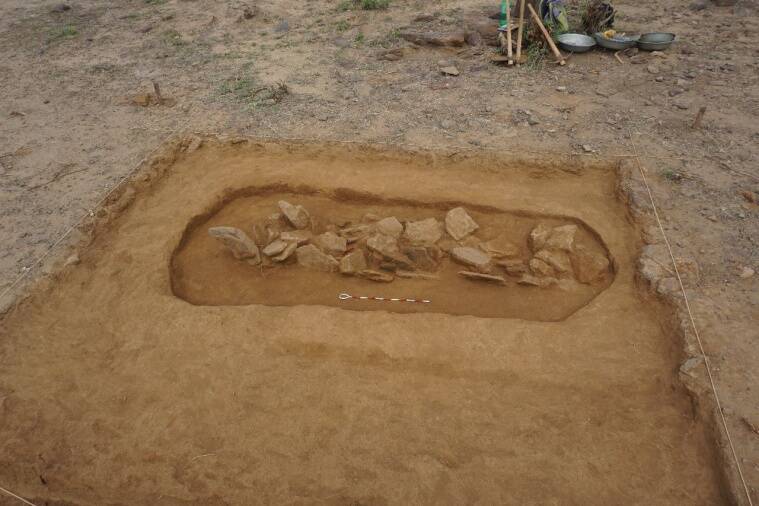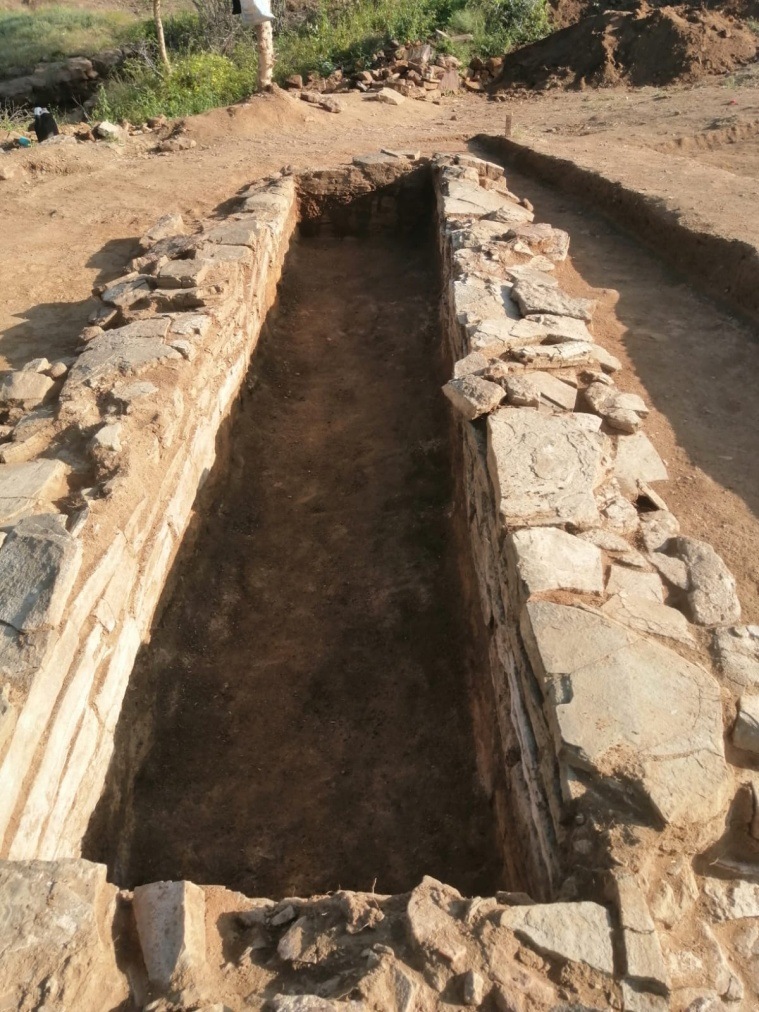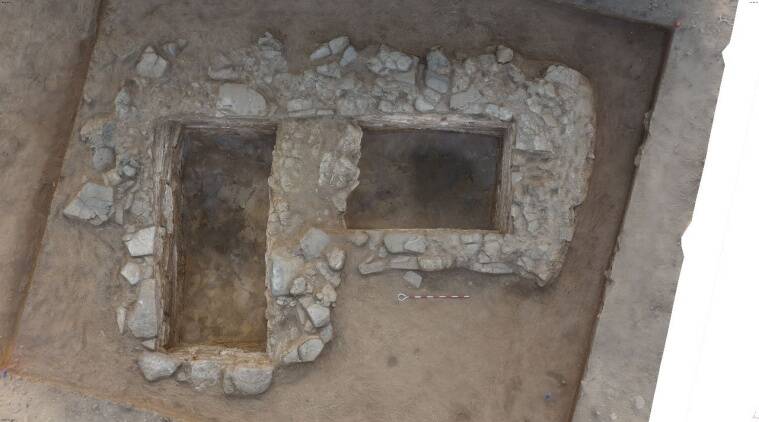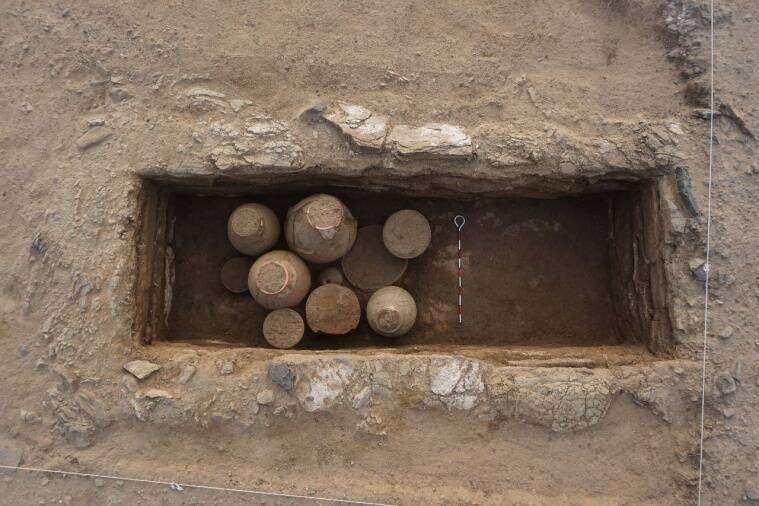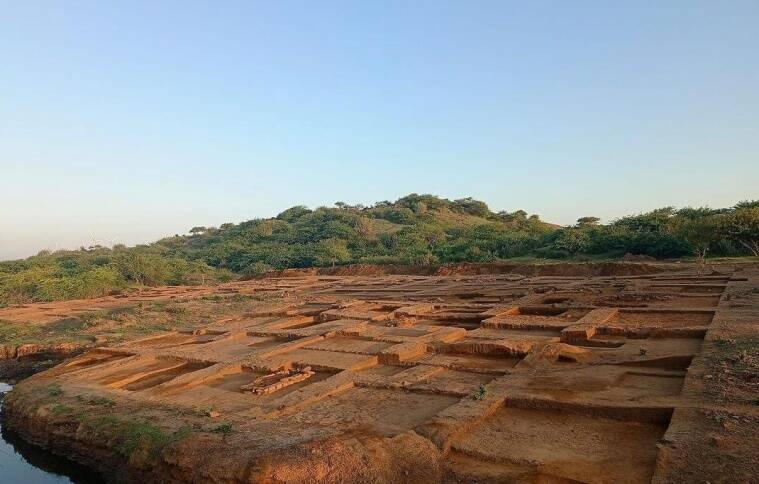At a Kutch Harappan graveyard, team works to unlock a mystery: Life and times of those buried
The burial site, spread over 16 hectares in a Kutch village, is considered to be the largest pre-urban Harappan cemetery
 At the Khatiya excavation site in Kutch, Gujarat. (Courtesy of Prof Rajesh SV and Abhayan GS.)
At the Khatiya excavation site in Kutch, Gujarat. (Courtesy of Prof Rajesh SV and Abhayan GS.) The dry, arid soil on a 16-hectare expanse on the outskirts of Khatiya village in Gujarat’s Kutch district has thrown up several surprises — a shell bangle, pottery shards, stones blades, even human skeletal remains. Since 2018, a multi-disciplinary international team of archeologists has discovered 500 graves and excavated 197 of those here, but deep below, the site holds the key to an enduring mystery: whose graves are these?
Led by Rajesh S V, Assistant Professor in the Department of Archaeology in the University of Kerala, the researchers say that while it is established that the cemetery, believed to be 5,000 years old, belonged to the ‘pre-urban’ phase of the Harappan civilisation, they are still looking for clues to see if the burial ground — arguably the largest such cemetery — could have served a big human settlement in the vicinity or if it was a common facility for a cluster of smaller settlements.
The Harappan civilisation, one of the oldest in the world, is said to have thrived along the banks of river Indus from around 5,000 BC to 1,000 BC. While the 2,500-year-long period from 5,000 BC to 2,600 BC is known as the ‘pre-urban’ Harappan phase, between 2,600 BC and 1,900 BC is the ‘urban’ Harappan phase. From there on, the civilisation declines and 1,900 BC to 1,000 BC is considered the ‘post-urban’ Harappan period.
So far, the findings at the burial site are consistent with its pre-urban Harappan status.
The fragment of a shell bangle collected from the Khatiya cemetery and tested at Physical Research Laboratory (PRL), Ahmedabad, was found to be dating back to 2,850 BC. Prof Abhayan G S, Assistant Professor of Kerala University who is a co-director of the excavation project at Khatiya, said, “The pottery found as burial goods at the Khatiya site, mainly redware, buffware and grayware, is comparable to the pre-urban Harappan pottery of Sindh and Balochistan and North Gujarat.”
However, he said, “The soil in Khatiya is acidic, facilitating faster decomposition of bodies. Therefore, researchers are finding it hard to extract DNA from samples excavated from this site.”
This could then hold the answer to the Khatiya puzzle — who are the people whose remains were interred in these graves and where did they come from?

While Dholavira, the UNESCO World Heritage Site and one of the biggest metropolises of the Harappan civilisation, is also in Kutch, it is 150 kilometres away from Khatiya that’s among the western-most of the Harappan sites in India. Given the distance, researchers say, it’s unlikely that people in the urban settlements of Dholavira were buried at the Khatiya site.
“Desalpar and Khirsara, Kotda Bhadli and Nadapa are the other well-known Harappan sites in western Kutch. But each of them is a site of urban and post-urban periods of the Harappan civilisation and more than 50 km away from Khatiya. Being a pre-urban Harappan cemetery, there is a possibility that either there was a big settlement in Khatiya or there were smaller settlements around Khatiya and the cemetery was a common burial ground for them,” said Prof Rajesh, who has studied regional chalcolithic cultures (Copper Age) of Gujarat as part of his doctoral research project.
The international team of collaborators included 27 archaeologists, DNA analysts, geologists and GIS specialists from Gujarat, Maharashtra, Kerala, Spain, USA, Japan and Sweden.
Prof Subhash Bhandari, associate professor and head of Krantiguru Shyamji Krishna Verma Kachchh University (KSKVKU), Bhuj, Kutch is also part of the international team of researchers.
Having excavated parts of the cemetery in 2018-19, 2019-20 and 2021-22, Prof Rajesh, Prof Abhayan and their team are now preparing to move to a new site — Padada Bhit, a hillock on whose side there are some visible mounds. “The Padada hillock is around 1.5 km from the cemetery. But we believe the two are related,” said Prof Rajesh, who has previously worked on archaeological explorations at the Harappan sites of Navinal, Deshalpar, Janan, Mundra, Moti Chher and Nadapa in Kutch.
The team has also identified a place in Lakhapar, a village two km away, which, it is believed, could hold clues to the Khatiya cemetery.
Part of Lakhapar panchayat, Khatiya is located on the banks of the Gandi, a stream that drains into the Great Rann of Kutch (GRK). Today, the GRK is an expanse of saline mudflats, but archaeologists believe it used to be navigable in prehistoric times and that the Ghaggar-Harka-Nara river used to flow through it. Later, the river dried up, turning Kutch into an arid region.
At a Kutch Harappan graveyard, team works to unlock a mystery: Life and times of those buried
Read More: https://t.co/MPpynKDnIE pic.twitter.com/DyJzbPuK9L
— The Indian Express (@IndianExpress) May 22, 2023
While the researchers are preparing for their fourth excavation season this winter, in Khatiya — which has a population of merely 100, mostly of farmers or cattle-herders — villagers say they are doing their best to protect the mounds.
“A pond was dug on the south-western periphery of the ancient burial site in 2016 as part of the government’s initiative to harvest the water of Dhoro Chhelo (a stream). Lots of graves were damaged during that time,” says Narayan Jajani, 65, the former sarpanch of Lakhapar-Khatiya panchayat who was the first to alert Prof Rajesh about the cemetery when the team was conducting an exploration in the area in 2016.
Isak Sumra, the present sarpanch, says elders in the village would talk about the cemetery. “They used to say that Juna Khatiya (old Khatiya) village used to be north of this burial ground. But now, after the excavation, they are saying ours is a 5,000-year-old village. That makes us special,” says the 59-year-old.


